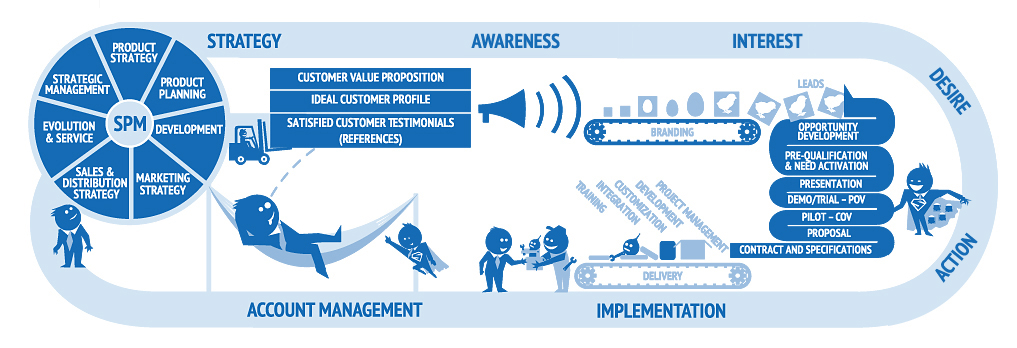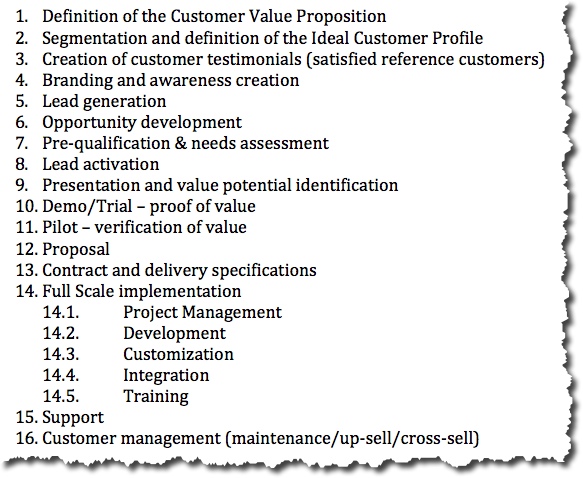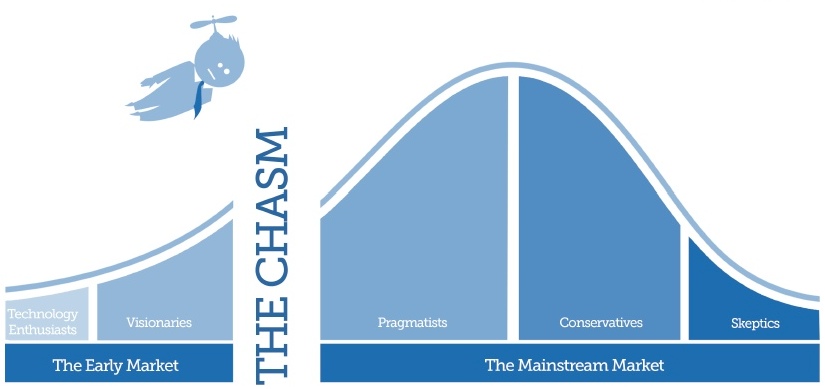Successful Channel Building in The Software Industry #1
Using a channel of independent companies to resell, implement and/or service customers has a long tradition in the history of the software industry. For some software companies the channel has been a major contributor to global success, but for most software companies making it work is a depressing and constant struggle.
The word “channel” is used in the software industry to describe independent companies that assume various roles and obligations in bringing a software product to the customers. The definition is rather broad, since the roles and obligations can vary substantially from “simple” reselling to system integration, solution development on top of the software, implementation in terms of consulting, project management, customization, training and support.
Building and operating a successful partner channel requires the understanding of two fundamental concepts:
- The Value Chain. [slider title=”Reference”] The Value Chain concept is described in TBK-PFFS-005, which is available on www.tbkconsult.com [/slider]
- The Three Phases of Market Penetration
The value chain approach
The objective of any software driven company is to get happy customers and grow the installed base to a position where the company is the market leader.
[slider title=”The Value Chain”] The Value Chain reflects the customers’ purchase and implementation process and your corresponding sales and implementation process. [/slider] remains the same from initial market bootstrapping to global dominance. However the effort associated with exercising the various parts of the value chain changes dramatically through the journey.
Let’s take a look at a normal Value Chain in the software industry as illustrated above:
The energy and insight required to perform each step of this value chain varies substantially depending on whether you are in the bootstrapping phase or in the path to market dominance.
The three phases of market penetration
The path from local to global market dominance in the software industry goes through three phases.
- Bootstrapping
- Bridgehead
- Dominance
Bootstrapping is the process of getting the first minimum critical number of customers in a new territory and growing the revenue, which will allow you to establish your own presence in that market.
Bridgehead is the phase where you establish your own presence in the market and grow your market penetration to full geographic coverage.
Dominance is the phase where you consolidate your position into your selected vertical industries. Dominance obviously requires full geographic and vertical coverage. From a position of dominance you can become the eco-system owner.
The channel, the value chain and the three phases
Let’s explore what to do in each of the 3 phases to create your position and steadily grow to the next phase, when a partner channel is a part of your GTM strategy.
Bootstrapping
Let’s make a blunt statement:
A channel partner will be reluctant to sell a new product to his existing customers. A channel partner cannot sell a new product to a new customer.
Bootstrapping into a new market through partners will seldom work. Winning the first critical reference customers requires that you be in front of your partners basically doing the job for them.
Customer Value Proposition
You need to know your customer value proposition extremely well and it must be thoroughly documented. We recommend using a standard format for describing you customer value proposition such as the [slider title=”NABC format”] The NABC format is described in the document TBK-PFFS-002, which is available on www.tbkconsult.com [/slider]
Your value proposition must have a very clear competitive edge. Selling something, which is already available in the market with established references and local support is very, very difficult. Thus your value proposition must explain why your proposal is better than the already available alternatives.
Ideal Customer Profile
As described in the Value Chain Approach you must define an Ideal [slider title=”Customer Profile”] The format for describing the Ideal Customer Profile is explained in the document TBK-PFFS-003, which is available on www.tbkconsult.com [/slider] in order to identify which customers you should approach first. The challenges associated with breaking into a new market also apply to the situation of breaking into a new geography. We recommend studying Geoffrey Moore and his renowned book “Crossing the Chasm.
Your challenge is that the main market is available to neither you, nor your potential partners. Somehow you need to identify and approach technology enthusiasts and visionaries first or at least identify potential customers who will derive massive short-term benefit from using your software.
Mitigating major risk in the bootstrapping phase
The primary risk factors in the bootstrapping phase are “time-to-revenue” and “the learning curve”.
It is hard to estimate how fast you can win the critical number of reference accounts. If you assign all steps in the value chain to partner(s) and provide him/them with some basic product training only, then your chances of success are very slim.
Partners are extremely sensitive to “time-to-revenue” and tend to reallocate resources if genuine sales opportunities do not mature within a 3-month window. The value of the basic training evaporates and you have to start all over again, if and when a new sales opportunity appears.
Experience shows that it takes real life projects to effectively travel the learning curve. Classroom seminars alone will not do the job. You must drive the sales effort associated with winning the first customer with the partner as a trainee. The second customer can be a 49/51 effort and the partner can drive the third customer project with you as the supervisor.
Selling to existing customers
You MUST insist starting with the partners existing customers. Selling a new product to an existing customer will cut at least 50% off the time-to-revenue.
Partners are reluctant to sell new products to existing customers because they are afraid it may jeopardize the customer relationship. The partner may be really excited about your product, but as he has no practical experience with the product he will “cool off” when it comes to actually making the first moves and introducing the product to his existing customers.
With a few exceptions partners are not professional sales and marketing machines. They are mostly technical oriented “feature creatures.” Therefore they have a hard time getting new customers. When they come across a new “sexy” product, they believe the product can open the doors to new customers. After a couple of attempts at getting the foot in door with new customers, they will be disappointed and shift their focus elsewhere.
It is your job to insist on starting with the existing customers. You must work with the partner identifying the “buying” centers and work according to your Value Chain approach. You must drive the sales effort and take an active role in the subsequent implementation.
Conclusion
Bootstrapping cannot be left entirely to a partner. You have to take him by the hand and walk him through the learning curve until the first 3-5 customer projects have been completed and the revenue flows.
Working through a channel essentially requires additional investment as compared to the direct approach.
Believing that bootstrapping through a channel of partners is “less expensive” than the direct approach is based on false assumptions. Developing a partner channel is an additional investment. This investment will provide a return later on, providing sales and implementation capacity in the market over and above what you could have generated through your own organic growth.
Other articles in this series
- The Best Process for Recruiting Channel Partners in the Software Industry
- What’s a best practice solution for managing channel partners in the software industry?
- Steps to designing and executing productive Partner Channel Programs in the software industry
- Partner P&L – the path to productive partners in the software industry
- Strategic Partner Development in the Software Industry











